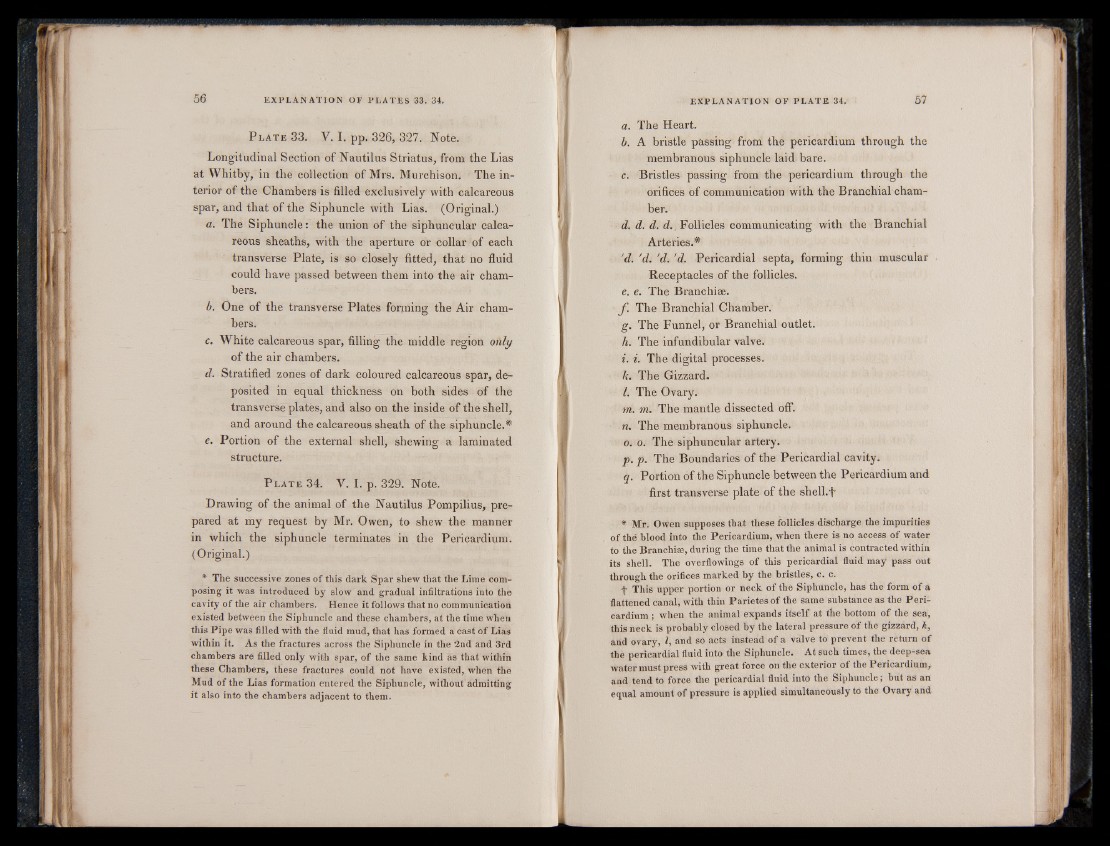
P late 33. V. I. pp. 326, 327. Note.
Longitudinal Section of Nautilus Striatus, from the Lias
at Whitby, in the collection of Mrs. Murchison. The interior
of the Chambers is filled exclusively with calcareous
spar, and that of the Siphuncle with Lias. (Original.)
a. The Siphuncle: the union of the siphuncular calcareous
sheaths, with the aperture or collar of each
transverse Plate, is so closely fitted, that no fluid
could have passed between them into the air chambers.
b. One of the transverse Plates forming the Air chambers.
c. White calcareous spar, filling the middle region only
of the air chambers.
d. Stratified zones of dark coloured calcareous spar, deposited
in equal thickness on both sides of the
transverse plates, and also on the inside of the shell,
and around the calcareous sheath of the siphuncle.*
e. Portion of the external shell, shewing a laminated
structure.
P late 34. V. I. p. 329. Note.
Drawing of the animal of the Nautilus Pompilius, prepared
at my request by Mr. Owen, to shew the manner
in which the siphuncle terminates in the Pericardium.
(Original.)
* The successive zones of this dark Spar shew that the Lime composing
it was introduced by slow and gradual infiltrations into the
cavity of the air chambers. Hence it follows that no communication
existed between the Siphuncle and these chambers, at the time when
this Pipe was filled with the fluid mud, that has formed a cast of Lias
within it. As the fractures across the Siphuncle in the 2nd and 3rd
chambers are filled only with spar, of the same kind as that within
these Chambers, these fractures could not have existed, when the
Mud of the Lias formation entered the Siphuncle, without admitting
it also into the chambers adjacent to them.
a. The Heart.
b. A bristle passing from the pericardium through the
membranous siphuncle laid bare.
c. Bristles passing from the pericardium through the
orifices of communication with the Branchial chamber.
d. d. d. d. Follicles communicating with the Branchial
Arteries.*
'd. 'd. 'd. 'd. Pericardial septa, forming thin muscular
Receptacles of the follicles.
e. e. The Branchiae.
f . The Branchial Chamber.
g. The Funnel, or Branchial outlet.
h. The infundibular valve.
i. i. The digital processes.
k. The Gizzard.
l. The Ovary.
m. m. The mantle dissected off.
n. The membranous siphuncle.
o. o. The siphuncular artery.
p. p. The Boundaries of the Pericardial cavity.
q. Portion of the Siphuncle between the Pericardium and
first transverse plate of the shell.f
* Mr. Owen supposes that these follicles discharge the impurities
of thé hlood into the Pericardium, when there is no access of water
to the Branchise, during the time that the animal is contracted within
its shell. The overflowings of this pericardial fluid may pass out
through the orifices marked by the bristles, c. c.
f This upper portion or neck of the Siphuncle, has the form of a
flattened canal, with thin Parietes of the same substance as the Pericardium
} when the animal expands itself at the bottom of the sea,
this neck is probably closed by the lateral pressure of the gizzard, k,
and ovary, l, and so acts instead of a valve to prevent the return of
the pericardial fluid into the Siphuncle. At such times, the deep-sea
water must press with great force on the exterior of the Pericardium,
and tend to force the pericardial fluid into the Siphuncle; but as an
equal amount of pressure is applied simultaneously tö the Ovary and